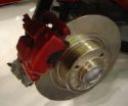 The brake system of your car is one of the most vital safety features that without which driving would be impossible. There are many things that can go wrong with your brakes and as preventive maintenance and regular inspection, it would be best to check on a few parts so you don’t get caught without brakes on the road.
The brake system of your car is one of the most vital safety features that without which driving would be impossible. There are many things that can go wrong with your brakes and as preventive maintenance and regular inspection, it would be best to check on a few parts so you don’t get caught without brakes on the road.
Under the hood of any vehicle there is a container or reservoir as it is called that contains brake fluid and to most drivers, is the most known part of the brake system. Don’t keep this only topped off but make sure you use the right type of brake fluid (DOT 3 is the most common brake fluid grade used). The metal thing this reservoir sits on is called the Master cylinder which contains the pistons that forces the fluid from the reservoir into the brake lines (more on the other parts as we go on) to the wheel cylinders. Directly behind that is a metal drum like thing that is the brake booster which has a rubber gasket inside which multiplies the amount of force exerted by your foot on the pedal into immense pressures to stop your car. The brake fluid then goes through the brake lines to each wheel which are actually metal pipes with some rubber hoses in tight corners and moving areas to the wheel cylinders. The wheels all have individual cylinders or pistons that push the brake pads or drums to close and stop the vehicle. The parts the pads come in contact with are the rotors for disk brakes and drums for drum brakes.
More on the next post regarding maintenance and troubleshooting of the brake system.